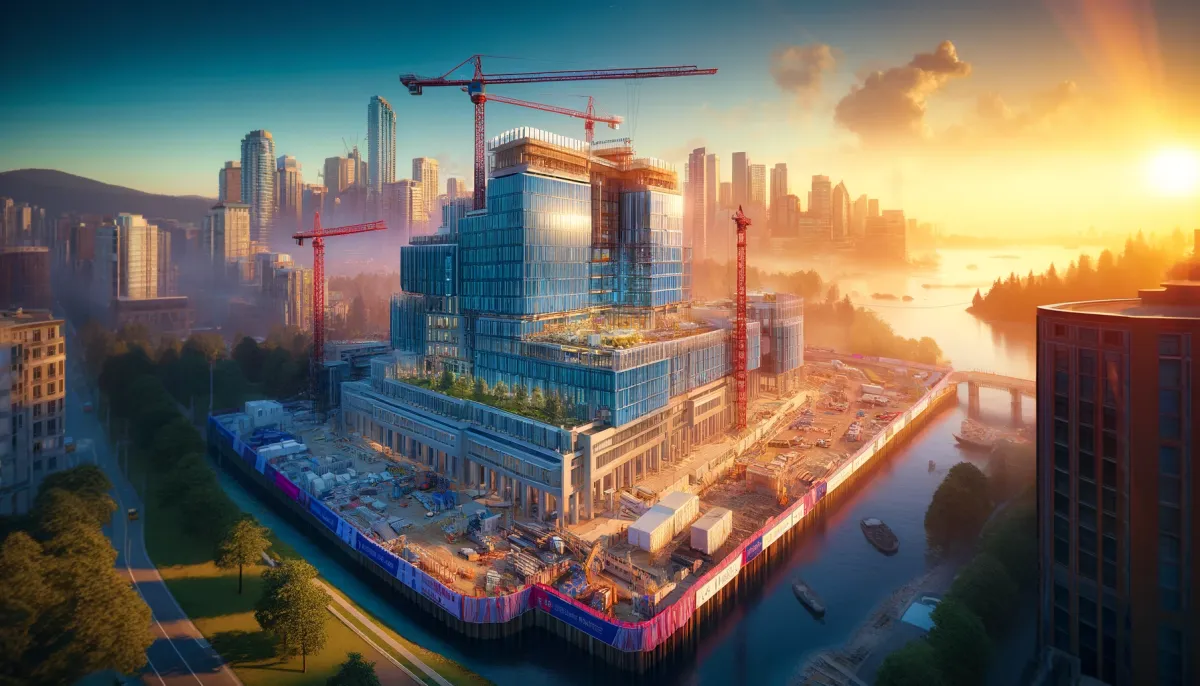
Vancouver, BC - May 27, 2025 - Vancouver is witnessing a transformative development in its healthcare landscape with the construction of the new St. Paul's Hospital in the False Creek Flats neighborhood. This state-of-the-art facility is set to replace the existing hospital on Burrard Street, enhancing medical services for the community.
Challenges of Building in a Swamp
The False Creek Flats area presents unique construction challenges due to its soft, water-saturated soils. Building on such terrain requires advanced engineering techniques to ensure stability and longevity. Crews are employing deep soil mixing and installing stone columns to reinforce the ground, mitigating risks associated with soil liquefaction during seismic events.
An area long defined by transportation and commerce, the present day False Creek Flats, up until the early days of the twentieth century, sat as a muddy tidal flat on the eastern end of False Creek. The rich variation of natural features, including a number of streams cutting down the southern escarpment, provided diverse and abundant resources for the First Nations people of the area and included some of
the largest salmon and trout runs in Vancouver.
As the industrial activity of Vancouver’s resource economy filled in the downtown peninsula and shores of False Creek, the City sought to accommodate further economic expansion and looked to the Mud Flats to accommodate some additional rail terminals. Following a favourable public vote, in 1915 the filling in of the Flats began utilizing a variety of materials including landfill from nearby development
projects, scrap lumber and bricks from surrounding mills and general industrial waste5. By 1917, the Flats were completely filled in and by 1919 both the Great Northern Railway (GNR) and Canadian Northern Railway had established their new western terminals in the False Creek Flats, thereby laying the foundation for the area’s industrial future.
State-of-the-Art Facility and Expansion
The new St. Paul's Hospital is designed to be a cutting-edge healthcare institution, integrating the latest medical technologies and patient-centred design principles. The facility will offer expanded services, including enhanced cardiac care, kidney care, and mental health services. The design emphasizes natural light, green spaces, and a healing environment to promote patient well-being.
Besides being people first, earthquake safe and pandemic ready, it will also be built to FUTURE PROOF standards:
- Fully equipped to network with clinicians, researchers, and scientists in BC and around the world.
- Opportunities to collaborate nationally as a founding member of Canada’s Digital Technology Supercluster and within the Pacific Northwest’s expanding Cascadia Innovation Corridor initiative.
- In addition to the Clinical Support and Research Centre, future development may include other centres for excellence such as a Centre for Healthy Aging, an Indigenous Wellness and Welcoming Centre, and more.
- Everything from patient check-in, to scheduling, to security is controlled by a clinical operations centre – similar to an air traffic control tower.
Investors and Funding
The project is a significant investment in British Columbia's healthcare infrastructure. In 2020, Providence Health Care sold the existing St. Paul's Hospital site on Burrard Street to Concord Pacific for nearly $1 billion. The proceeds from this sale are being directed towards the construction of the new hospital, demonstrating a strategic reinvestment into the province's healthcare system.
Timeline of the Building Project
Construction of the new hospital commenced in 2021, with an expected completion date in 2027. The project is progressing through multiple phases, including site preparation, foundation work, structural framing, and interior outfitting. All new hospitals in B.C. are planned to a Leadership in Energy and Environmental Design (LEED) Gold standard at minimum. Upon completion, the facility will also undergo rigorous testing and commissioning before opening its doors to patients.
Also, the new space will incorporate what’s called an “on-stage/off-stage” design. It’s a concept borrowed from the theatre world and built on the premise that the audience (patients and families) needs different things than the cast and crew (staff). This means that public spaces (exam rooms, labs, waiting areas) will be separate from private or utilitarian spaces (nursing stations, break rooms, offices, storage). It’s a simple, effective way to reduce wait times, simplify wayfinding, enhance privacy, and ensure people and equipment can move through the hospital safely and efficiently.
History of St. Paul's Hospital
The existing St. Paul's Hospital on Burrard Street has been a cornerstone of Vancouver's healthcare since its establishment. When first opened in 1894, the hospital was a 25-bed, four-story, wooden building serving Vancouver’s small population of 14,000 people. Founded by the Sisters of Providence, a Montreal-based Catholic group, St. Paul’s gradually expanded to meet Vancouver’s growing demand. The original building was designed and built by Mother Joseph of the Sacred Heart, a female carpenter and the first female architect on the west coast.
By 1906, the hospital was the first of its kind to have an x-ray machine and by 1914, the wooden frame was replaced with the fire-proof brick structure we now see today, along with 120 more beds. A School of Nursing was also opened at the hospital in 1907, playing an important role in Vancouver’s medical training landscape. In the 1930s, a north and south wing were added to both ends of the hospital, adding another 500 beds to aid increasing demand. At the time, the only other hospital in the region was Vancouver General Hospital in Fairview.
By the 1970s, the hospital needed another expansion to meet its responsibilities as a referral and tertiary care centre. Hence, plans began for two 10-story towers to be built adjacent to the original building, now called the Centre Block. The towers were completed in 1983 and 1991. In 2010, the province of B.C. opened St. Paul’s new $14.7 million emergency room for expedited admissions and improved patient care. Just outside the new emergency entrance on Burrard Street, is the now popular ‘Lights of Hope’ Christmas light display every winter.
Demolition and Commemoration of the Old Hospital
While specific dates for its decommissioning and demolition have not been publicly announced, it is anticipated that these activities will commence shortly after the new facility becomes operational. Plans for commemorating the old hospital are underway, with discussions focusing on preserving its historical significance. Potential initiatives include archival documentation, public exhibitions, and the incorporation of artifacts into the new hospital's design to honour the legacy of the original institution.
This development marks a significant milestone in Vancouver's commitment to advancing healthcare services, ensuring that residents have access to top-tier medical care in a modern, purpose-built environment.
#Vancouver Hospital #Healthcare Innovation #St Pauls Hospital #Downtown Vancouver #Hospital Construction #Medical Advancements #BC Health #City Development #WBN News Vancouver #Elke Porter
Connect with Elke at Westcoast German Media or on LinkedIn: Elke Porter or contact her on WhatsApp: +1 604 828 8788

